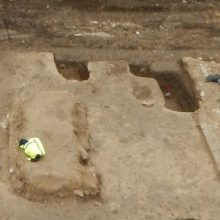
Photo from archive.org
This article describes a path to addressing the discomfort that I and many of my braver colleagues have had, when putting words into the mouths and heads of prehistoric actors,… Click to show full abstract
This article describes a path to addressing the discomfort that I and many of my braver colleagues have had, when putting words into the mouths and heads of prehistoric actors, knowing that these words say more about us than they do about prehistory. Yet without such speech, how are we archaeologists and the broader public to imagine the intangibles of the deep past (emotions, affect, gender, senses)? Moreover, such words create a misleading certainty that conceals the ambiguities of the archaeological data. Are there alternative options to verbal and vocal clarity when creating imagined fictive narratives about the past? With inspiration from composer Györgi Ligeti, from linguists and experimental psychologists, and from ASMR (Autonomous Sensory Meridian Response) performers, I explore the emotive power of vocal non-verbal interjections and utterances that have more universality and less cultural baggage, using them in three diverse re-mediations of digital media from three prehistoric archaeological contexts in Europe and Anatolia. Le chemin parcouru pour surmonter la gêne ressentie par moi-même et maints collègues plus courageux quand il s'agit de mettre des mots dans la bouche et la tête de personnages préhistoriques, sachant bien que ces mots en disent plus sur nous que sur la préhistoire, forme le sujet de cet article. Mais s'ils restent muets, comment les archéologues et le grand public peuvent-ils imaginer les aspects intangibles d'un passé très ancien (sentiments, émotions, genre, sens) ? En outre, ces mots créent un climat de certitude trompeuse qui masque les ambigüités des données archéologiques. Existe-t-il des alternatives aux paroles trop précises quand on tente d'imaginer des récits fictifs situés dans le passé ? En m'inspirant du compositeur Györgi Ligeti, des travaux de linguistes et de chercheurs en psychologie expérimentale, et de praticiens de l'ASMR (Réponse Automatique des Méridiens Sensoriels), j'examine ici le pouvoir émotionnel de la voix dans ses interjections et expressions non verbales de caractère plus universel et moins chargées de bagage culturel. Je présente ainsi trois essais de re-création numérique illustrant trois situations préhistoriques provenant de contextes archéologiques en Europe et en Anatolie. Translation by Madeleine Hummler In diesem Artikel beschreibe ich den Weg zur Überwindung der Unzufriedenheit, die ich und manche mutigere Kollegen empfinden, wenn es darum geht, Worte in den Mund oder Kopf von urgeschichtlichen Personen zu stecken, in dem Bewusstsein, dass diese Worte mehr über uns als über die Urgeschichte erkennen lassen. Aber wie können sich die Archäologen und die breite Öffentlichkeit die immateriellen Aspekte der tiefen Vergangenheit (wie Gefühle, Gemütsbewegungen, Geschlecht oder die Sinne) ohne Sprache vorstellen? Darüber hinaus geben solche Aussagen einen falschen Eindruck, der klarer als die unbestimmten Angaben der archäologischen Daten ist. Gibt es alternative Möglichkeiten, die sprachliche Äußerungen ausschließen und die es ermöglichen, fiktive Erzählungen über die Vergangenheit aufzubauen? Vom Komponisten Györgi Ligeti inspiriert und von den Arbeiten von Sprachwissenschaftler und experimenteller Psychologen sowie Praktikern der sogenannten Autonomous Sensory Meridian Response (ASMR) angeregt, untersuche ich die emotionale Kraft von nonverbalen Ausrufen und Äußerungen, die eher einen allgemeingültigen Charakter haben und weniger kulturell geprägt sind. Ich stelle hier drei verschiedene Versuche vor, die durch den Einsatz digitaler Medien entstanden sind und drei urgeschichtliche Situationen in Europa und Anatolien schildern. Translation by Madeleine Hummler
Journal Title: European Journal of Archaeology
Year Published: 2019
Link to full text (if available)
Share on Social Media: Sign Up to like & get
recommendations!